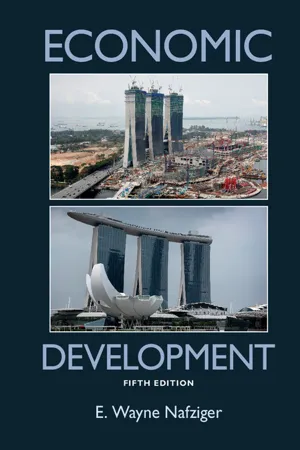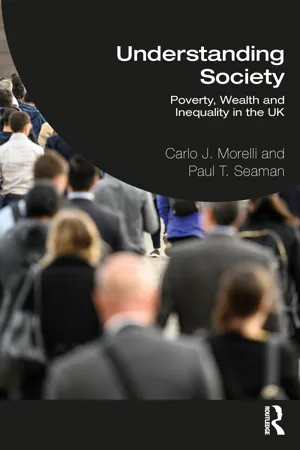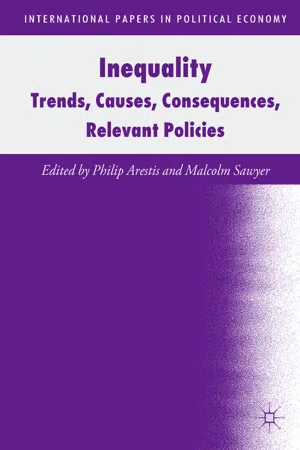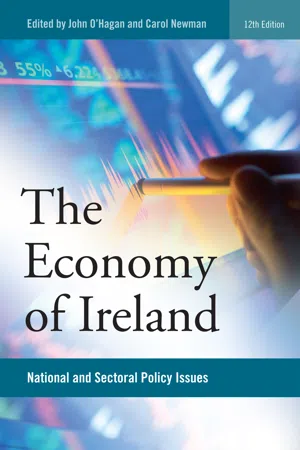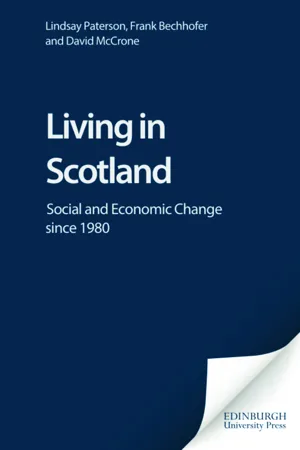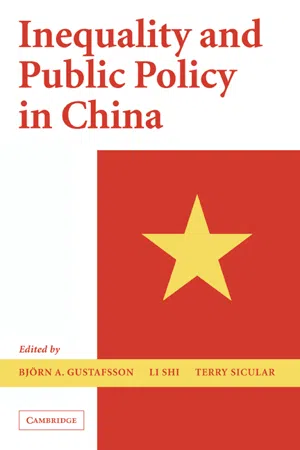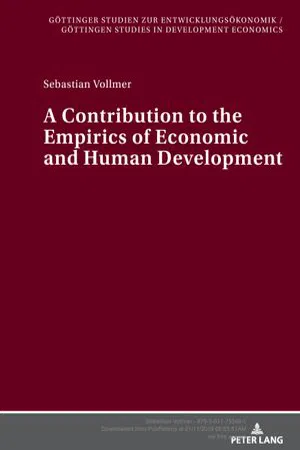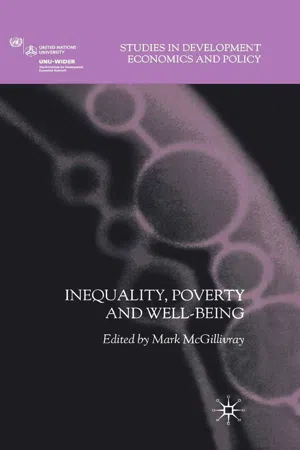Social Sciences
Distribution of Wealth, Poverty, and Income in the UK
The distribution of wealth, poverty, and income in the UK refers to the unequal allocation of financial resources among the population. It encompasses the disparities in assets, earnings, and living standards across different socioeconomic groups. This topic is of significant interest in understanding social and economic inequalities within the UK.
Written by Perlego with AI-assistance
Related key terms
1 of 5
10 Key excerpts on "Distribution of Wealth, Poverty, and Income in the UK"
- eBook - ePub
Capitalism in the UK
A Perspective from Marxist Political Economy
- Mike Campbell(Author)
- 2023(Publication Date)
- Routledge(Publisher)
1The pattern of wealth distribution in the UK is not a peculiarly UK phenomenom rather it is a basic feature of all capitalist societies, though of course the degree of inequality observed does vary to some degree.2 This implies that despite many institutional, cultural and policy differences between countries, the basic cause of inequality is common to them all i.e. an economic system based on capitalist relations of production. The Inland Revenue publish estimates of the distribution of wealth based on estate duty returns which is a major source of information on wealth distribution, because individuals, and not all individuals at that, are only required at death to reveal their net wealth holdings, for the purpose of filling in a return for estate duty payment. According to these estimates the distribution of wealth is becoming increasingly diffused and more equally distributed over time. For example their figures show a decline in the Gini co-efficient of concentration from 0.76 in 1960 to 0.65 in 1970.3 However, the Inland Revenue data in its basic form is unreliable and inaccurate for a number of reasons.4 First, the estimates cover less than half of the adult population for they are based on the estates on which duty was paid or probate needed in that year and in consequence more than half of those dying annually are excluded from the statistics. These exclusions of individuals, generally with zero or very small amounts of wealth, are thus ignored in the data and hence the degree of concentration is understated. Moreover this only gives us information about those dying in a particular year, so that to convert the data to an estimate of the distribution of wealth of the living requires the assumption that those who die in any year are a random sample of the living population, and moreover requires the use of the ‘mortality multiplier’ to achieve this estimate. Secondly, the wealth of those who are covered by the data is understated mainly because of the use of tax avoidance techniques by individuals, including the transfer of wealth as a ‘gift’ to others which is then exempt from duty,5 - eBook - PDF
- E. Wayne Nafziger(Author)
- 2012(Publication Date)
- Cambridge University Press(Publisher)
Scope of the Chapter Despite data weaknesses, a few studies can provide estimates of global income dis-tribution and aggregate national poverty and income inequality and suggest policies to reduce them. We begin by indicating the multifaceted nature of poverty. We examine global income inequality and then discuss $1 or $1.25/day and $2/day poverty, global and regional poverty, the effect of poverty on access to education and health, what has happened to poverty since the beginning of the nineteenth cen-tury, the three measures of poverty and deprivation of Amartya Sen, his capabilities approach to poverty, the Lorenz curve and Gini index for measuring global and country income distribution, views of poverty by the World Bank and two critics, Kuznets’s inverted-U explanation for changes in income distribution with growth, Adelman and Morris’s dual-economy stage theory of the inverted-U curve, and the differences in poverty and inequality by: (1) low-, middle-, and high-income countries (LICs, MICs, and HICs, respectively); (2) DCs and LDCs; (3) slow-and fast-growing countries; and (4) gender. We analyze accompaniments of absolute poverty, iden-tify subgroups within a country’s population that are most hurt by poverty, and present several case studies of policies developing countries have used to influence poverty and income distribution. Finally, we suggest policies for reducing poverty and improving income distribution and discuss the relationship between inequality and political instability. Poverty as Multidimensional Deepa Narayan et al.’s ( 2000 :4–5) study is based on numerous World Bank surveys and reports of a representative sample of 60,000 poor people from sixty develop-ing countries during the 1990s. The World Bank and the authors ask two major questions: How do poor people view poverty and well-being? What are their prob-lems and priorities? The poor see that Poverty is multidimensional . - eBook - ePub
Understanding Society
Poverty, Wealth and Inequality in the UK
- Carlo Morelli, Paul Seaman, Carlo J. Morelli, Paul T. Seaman(Authors)
- 2022(Publication Date)
- Routledge(Publisher)
4 THE TOP 10% Income and wealth inequalityDOI: 10.4324/9781315179957-4Introduction
In Chapter 3 , we demonstrated how the use of the UK Household Longitudinal Study (UKHLS), Understanding Society, could be utilised to examine the characteristics of households in extreme poverty and test for the validity of the policy discourse around a deserving and underserving poor. The evidence derived from the data demonstrated the structural nature of extreme poverty in which specific household characteristics not only increase the likelihood of a household falling into the lowest 10% of the income distribution but also ensure the household’s ability to escape extreme poverty is severely curtailed. The conclusion drawn from these findings was that extreme poverty is a socially constructed structural phenomenon within the UK, developed through specific ideologies aimed at creating an ‘undeserving’ pool of extreme poverty. Poverty and inequality are therefore not simply due to differences in human decision-making but instead linked to structural features of the UK economy whose influence differentially impacts upon those at the bottom of the income distribution. However, it is not sufficient just to locate the existence of extreme poverty as structural poverty when examining inequality. We have to be able to examine the extent of similar structural inequalities existing elsewhere within the income distribution, and in particular in the area of extreme wealth for the highest income households.The extent of poverty and inequality then is a social decision in any society and those at the bottom of the income distribution are required to suffer the consequences for this decision-making while those at the top benefit from these social decisions. Thus, while the conclusion drawn from this approach is to suggest that government has an important role to play in the creation and implementation of redistributive policies, there is also a need to examine the extent to which redistribution is feasible within the income distribution. In order to demonstrate the potentiality of redistribution, we require an understanding of not simply those at the bottom of the income distribution but also those at the top. - eBook - ePub
Inequality
Trends, Causes, Consequences, Relevant Policies
- Philip Arestis, Malcolm Sawyer, Philip Arestis, Malcolm Sawyer(Authors)
- 2018(Publication Date)
- Palgrave Macmillan(Publisher)
2015 ).As discussed in the literature, and as we will observe in this chapter, the increasing income and wealth inequality worldwide has increased economists’ interest to investigate income and wealth distributions with a special focus on the recent growth at the top tails of both distributions (Piketty 2014 ; Benhabib et al. 2017 ).Inequality (of both income and wealth) has become an increasing universal concern among economists, policymakers and citizens. The reasons behind this phenomenon have been under debate for a long time and it seems probable that it will continue to be an ongoing topic in future. This study aims to examine whether house price evolution in Great Britain over the last decade has played any role in changing household wealth distribution, contributing somehow to the increase in wealth inequality among households. Moreover, our scope also focuses on the geographical allocation of net aggregate and property wealth, in particular, across the several government office regions of GB in order to observe the wealth concentration patterns of the different household groups.In the next sections, we build a theoretical framework drawing on the extensive international literature on wealth. In particular, we discuss, its constituents, the factors that affect wealth along with its effects on households, the well-documented term of ‘wealth inequality ’ and the evolution of wealth inequality both globally and focusing on GB. For the purposes of our empirical analysis, data on household wealth for GB had been very limited. It is only after July 2006 that sufficient household wealth information has been effectively collected by the Office of National Statistics (ONS) through the Wealth and Assets Survey (WAS) .2 It is important to mention at this point that at the time our analysis was undertaken, data of wave 5 from latest WAS concerning the period July 2014–June 2016 were not yet released, while just before our submission, the report of the main findings of this wave was published. Therefore, most of our analysis is based on the earlier trends while some of our figures incorporate the most recent data and refer to the latest report released by ONS. Our empirical analysis includes data of the first four waves available covering data on household wealth from July 2006 to June 2014. After discussing the distribution of wealth across GB in Sect. 3 , we provide some empirical evidence to show that house prices significantly affect wealth distribution in the country. Next, we present an extensive discussion of whether the changes in house prices have played any role to the increase in wealth inequality - eBook - ePub
The Economy of Ireland
National and Sectoral Policy Issues
- John W. O'Hagan, Carol Newman, John W. O'Hagan, Carol Newman(Authors)
- 2014(Publication Date)
- Gill Books(Publisher)
7 Estimates also suggest that the top 1 per cent of the Irish population hold 20 per cent of the wealth, the top 2 per cent control 30 per cent, and the top 5 per cent disposed of 40 per cent of private assets. When the value of housing is excluded, the distribution of financial wealth is more unequal, with the top 1 per cent controlling 34 per cent of all wealth. These numbers suggest that wealth is more unevenly distributed than income in Ireland and this conclusion is consistent with international experience; even in countries with relatively equal income distributions such as Germany and Sweden, the distribution of wealth is very unequal.Despite the fact that some older people in Ireland tend to suffer from relative poverty, a second group of older people enjoy significant personal wealth, such divergence reflecting the outcome of a lifetime of divergent income paths and investment decisions. This divergence occurred during Ireland’s economic expansion between 1994 and 2007 as significant increases in returns to employment occurred in some professions and at management level in the private sector, while stock market and property investments early in the period produced very high returns. As property prices and the stock market have fallen significantly since 2007, inequality in wealth will have reduced somewhat in Ireland.Poverty OutcomesAbsolute PovertyPoverty can be described as the state of not having enough money to take care of basic needs such as food, clothing and shelter. At a broad level, poverty can be measured in either absolute or relative terms and is generally calculated as a head count indicator; the fraction of the population falling below a minimum standard of income. Absolute poverty is defined as the fraction of the population below some threshold of income. The simplicity of absolute poverty, and its specified income level, is undermined by the need to change the threshold income level as countries grow and the cost of living rises. For example, a measure of absolute poverty in 1960s Ireland would be out of date in the 21st century.The theoretical distinction between inequality and poverty is worth noting. In our measures of inequality, some households (exactly 10 per cent) must be by definition located in the bottom 10 per cent of the income distribution. As a result, stagnant inequality is consistent with falling absolute poverty, where the poorer members of society are able to enjoy a superior standard of living. - eBook - PDF
Living in Scotland
Social and Economic Change since 1980
- Lindsay Paterson, Frank Bechhofer, David McCrone(Authors)
- 2004(Publication Date)
- Edinburgh University Press(Publisher)
It is true that there are formidable technical difficulties in making even mod- erately reliable estimates of wealth but the extensive publications of the Royal Commission on the Distribution of Income and Wealth (1977) showed that it is not impossible. However, with the arrival of the years of the Thatcher governments, willingness to invest in detailed research on the distribution of wealth waned, though in recent years the Inland Revenue has taken the task forward. The extent to which the unequal distribution of income, and of wealth from savings, property and other investments, is seen as significant (or even Ð 59 Ð to be deplored) is to a considerable extent a matter of political and social opinion about the appropriate balance between equality, redistribution, and rewarding talent and effort in a society. The inheritance of wealth is self- evidently not about rewarding the receiver's efforts, but raises issues about redistribution versus individuals' right to pass on what they have created or themselves inherited to their children and other individuals. These are controversial issues and it is not our task to explore them here. There is, however, rather more consensus that very low incomes and high levels of poverty are unacceptable, especially when children are adversely affected. So the subject of this chapter is whether people as a whole have become better off in the last twenty years, and how resources are distributed. The rise in income The average weekly gross income per household in Scotland, allowing for inflation, increased by just over a fifth between 1979 and 1997. The year-on- year increase and the three-year moving average of income (indexed to 1979) in Figure 5.1 show how income after a period of relative stagnation rose steadily in the second half of the 1980s, and after a brief dip in the early 1990s continued to rise. The mean weekly household income in 1997 was £367.40 (Table A5.1). - eBook - PDF
- Björn A. Gustafsson, Li Shi, Terry Sicular(Authors)
- 2008(Publication Date)
- Cambridge University Press(Publisher)
FIVE The Distribution of Wealth in China Zhao Renwei and Ding Sai I. Introduction China’s reform and openness have now been ongoing for a quarter cen- tury. During this important period, while China’s economy has developed rapidly and personal incomes have increased, changes in income distribu- tion, especially rising income inequality, have raised social concerns. Income and wealth are closely correlated. The people’s well-being depends not only on incomes but also on the level and distribution of wealth (Schneider 2004, pp. vii, 6). Since 1990 China has experienced a period of rapid accumulation of personal wealth combined with unequal distribution of that wealth. The country has established the objective of constructing a well-off society. The issue of wealth distribution thus has become a new focus of concern. In this chapter wealth, also called property or assets, includes land, hous- ing, and individual savings or holdings of other financial instruments, among other factors. Here the terms wealth, property, and assets are used as synonyms, but in different ways and from different points of view. When we link these assets with ownership we use the term “property rights.” Wealth and income are different concepts. Here income refers to all earn- ings of a person or a household in a certain period of time (usually a year). Wealth refers to the net monetary value of all assets at a certain point of time. In other words, wealth is the stock of all property at a certain point, while income is a flow of earnings in a time period. Obviously, income and wealth are interrelated. The previous flows of income affect the current stock of wealth; the current stock of wealth affects the flows of future income. Growth of wealth levels and changes in wealth structure and distribution affect This chapter was written by Zhao Renwei. Ding Sai contributed to the calculations. The authors would like to express thanks to Li Shi and Wei Zhong for their help. 118 - Sebastian Vollmer(Author)
- 2018(Publication Date)
- Peter Lang International Academic Publishers(Publisher)
Essay 3 Income Distribution Dynamics and Pro-Poor Growth 3.1 Introduction Over the past decade increased attention has been given to the evolution of global income in-equality and the connected questions of global welfare and poverty development. In the light of an ever intensifying globalization of the world economy, a rising concern is to identify global and regional winners and losers of this process. From a welfare point of view, the question might not be whether globalization generated economic growth per se, but rather how pro-poor this growth was or in other words which section of the global income distribution benefited most from the relatively successful global growth record of the past decades. Recent papers model the global income distribution, or a distribution limited to major economic players, by taking into account the underlying national income distributions (Dowrick and Ak-mal, 2005; Milanovic, 2002; Chen and Ravallion, 2004; Chotikapanich et al., 1997; Bourguignon and Morrisson, 2002; Quah 2002; Bhalla, 2002; Sala-i-Martin, 2006). In fact, an objective way to construct the global income distribution from the distinct national income distributions is as a population weighted finite mixture of the national income distributions. Intuitively, if one picks at random an individual with a certain income from this global income distribution, one first randomly draws the country it comes from (with probability equal to that countries proportion of the world population), and then obtains its income from the corresponding country income distribution. The main task in this approach is to determine the national income distributions. A debate continues concerning the data sources on which estimates of the income distributions should be based. Two main concepts have been used so far. The first approach, labeled Con-cept 2 by Milanovic (2006), combines national accounts income data with household survey inequality data to derive a global income distribution.- eBook - PDF
- M. McGillivray(Author)
- 2006(Publication Date)
- Palgrave Macmillan(Publisher)
7 Social Groups and Economic Poverty: A Problem in Measurement S. Subramanian Motivation This chapter combines the themes of poverty and inequality, within a mea- surement setting, with a view to elucidating some of the complications that can arise, and how these might be addressed, when we allow for a certain ele- mentary obtrusion of considerations of 'society' into routinely mainstream notions of the 'economy'. Specifically, the concern is with reckoning aspects of distributive justice from a group perspective, in addition to the more stan- dardly individualistic perspective, with an emphasis on the sorts of conflicts which these alternative perspectives could engender, and how these conflicts might be reconciled in the process of seeking a real-valued measure of income poverty. The two perspectives of distributive justice just alluded to are handily described by Stewart (2002) in the terms, respectively, of horizontal inequal- ity and vertical inequality. Much of received theorizing has been concerned almost exclusively with vertical inequality, which has tended to confine hor- izontal inequality, in a relative sense, to the unhappy status of what Stewart (op. cit.) calls 'a neglected dimension of development'. The question of why groups deserve a great deal more analytical and empirical attention than they would appear to have received in the discourse on poverty, inequality and development has been dealt with fairly exhaustively in Stewart's work, and therefore represents ground that one does not need to cover again here. Ref- erence, in this context, must also be made to earlier work, notably from the viewpoint of measurement, by Anand and Sen (1995), Jayaraj and Subra- manian (1999), Majumdar (1999), Majumdar and Subramanian (2001), and Subramanian and Majumdar (2002). - eBook - PDF
British Social Attitudes
The 27th Report
- Alison Park, John Curtice, Elizabeth Clery, Caroline Bryson, Alison Park, John Curtice, Elizabeth Clery, Caroline Bryson(Authors)
- 2010(Publication Date)
- SAGE Publications Ltd(Publisher)
* Karen Rowlingson is Professor of Social Policy and Director of Research at the Institute of Applied Social Studies at the University of Birmingham. Michael Orton is Senior Research Fellow at the Institute for Employment Research at the University of Warwick. Eleanor Taylor is a Researcher at the National Centre for Social Research and is Co-Director of the British Social Attitudes survey series. Do we still care about inequality? 1 BRITISH SOCIAL ATTITUDES 2 At the General Election in May 2010, there was a swing in public support from Labour to Conservative, suggesting that public support for redistributive policies was declining (Curtice, 2010). The resulting coalition government that came to power has stated an intention to tackle issues around inequality, declaring that “addressing poverty and inequality in Britain is at the heart of our agenda for government” (HM Government, 2010:1). However, the precise nature and effect of their policies on poverty and inequality are yet to be seen, though measures being taken to reduce the budget deficit look set to increase inequality still further. Understanding the public’s attitudes to inequality and redistribution, and how they may alter over the coming ‘period of austerity’ is important for policy makers and commentators alike. Of course, that is not to say that politicians will seek to take account of public opinion, or indeed to challenge it (as did Margaret Thatcher, as a ‘conviction politician’). However, understanding how people feel about inequality and redistribution and how that altered during the previous administration, will be a sound starting point for monitoring how they may change in coming years. So what does the British public think about inequality and redistribution? Recent analysis of British Social Attitudes data found that while a majority of the British public saw the gap between high and low incomes as too large, only a minority directly supported redistribution (Orton and Rowlingson, 2007).
Index pages curate the most relevant extracts from our library of academic textbooks. They’ve been created using an in-house natural language model (NLM), each adding context and meaning to key research topics.

